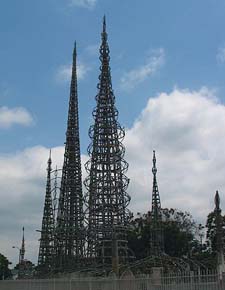-
Watts Tower
The Watts Tower or Towers of
Simon Rodia are located in the Watts district of Los Angeles,
California and is an odd collection of 17 interconnected structures,
two that reach up to heights of almost 100 feet. These magnificent
towers were constructed by an Italian immigrant construction worker
named Sabato, Sam or Simon, Rodia in his spare time, taking a full
33 years to complete, from 1921 to 1954. This special work is a
marvelous example of non-traditional vernacular architecture and
American Naive art. They were designated a National Historic
Landmark in 1990 and Robert Koehler, reviewer for the magazine
Variety, the documentary film called "I Build the Tower", is the
most complete visual perspective of this self-made architect called
Simon Rodia and his fantastic masterpiece. It is also listed on the
National Register of Historical Places, the California Historical
Landmarks and the LA Historic-Cultural Monuments. Rodia is believed
to have said, "I had in mind to do something big and I did it." The
sculptures' armatures are made of steel pipes and rods, wrapped with
wire mesh and coated with mortar. The main supports have been
embedded with pieces of tile, glass and porcelain and decorated with
scrap materials that Rodia found, like, sea shells, bed frames,
scrap metal, bottles and ceramic tiles. He named the towers Nuestro
Pueblo, or our town, and constructed them using no special
equipment, predetermined design, and worked alone with hand tools
and window-washer's equipment. The children of the neighborhood
would bring him broken glass and pottery, hoping that Rodia would
use them, but most of the items or materials were from his workplace
at the Malibu Pottery; he worked there for many years. The green
glass pieces can be recognized by their various parts that belong to
7UP, Canada Dry, Squirt and Bubble Up bottles, while the blue pieces
look like they were from milk of magnesia bottles. The majority of
the framework was scrap rebar, bent using nearby railroad tracks for
a vise, and some items came from walking the tracks of the Pacific
Electric Railway right of way that went between Watts and
Wilmington. Simon often walked the tracks looking for pieces he
could use, going all the way to Wilmington, which was 20 miles away.
In 1955, he gave the property away, and left, retiring to Martinez,
California; many said he had become tired of the abuse he received
from his neighbors and the vandals that occasionally got onto his
property when he was gone. He died 10 years later, never having
returned to his magnificent sculpture. His property was sold, with
his bungalow burning down and finally the city condemned the
structure and ordered that it be razed, but actor Nicholas King and
film editor William Cartwright went to the site in 1959, and saw the
sad neglect, so they purchased it for $3000 so that it would be
saved. The city found out and decided to demolish it before the
transfer could happen, in the meantime, it had become a world famous
and people from all over opposed the destruction. A group, made up
of King and Cartwright, and the curator of the LA County Museum of
Art, together with architects, artists and community activists
negotiated with the city to have an engineering test to see if the
towers could be dangerous to anyone in the district. A crane was
brought in and steel cable attached to each tower, then using
lateral force, tried to move the towers. Nothing moved, and when the
crane finally broke down, the test was considered finished and the
towers were saved. The city was given them in 1975, who then gave
them to the state in 1978. These spectacular towers are one of only
nine such folk art sites in the National Register of Historic
Places.
|

